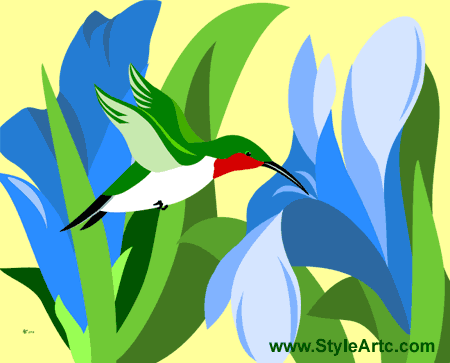GALLERY: Birds | Dogs| Wildlife
I think Hummingbirds are one of the most spectacular wonders in nature. I had the pleasure of being visited several times by these tiny energetic birds while sitting in my backyard. Ever since I saw the first one I've been eagerly awaiting each summer hoping one will pay me another visit. It's hard to contemplate that something so tiny travels so many hundreds, some even thousands of miles each year to reach their destination.
The artwork shown here is somewhat a first for me. It's my first digital painting made in a vector graphics program, and it's the first wildlife painting I attempted to give an abstract flair. I used only flat color to convey a contemporary, modern look and feel of this Ruby Throated hummingbird hovering around large blue flowers.
Hummingbird Gifts
In addition to prints, my hummingbird art can be purchased online on a variety of products and gift items such as mugs, mousepads, clocks and keychains from Zazzle
Hummingbird Facts
- Hummingbirds use their feet to perch but they don't use them to walk or hop
- they can hear better than us humans can
- average life span is around 5 years but they can live over 10 years
- their wings beat around 50-80 times per second and up to 200 times per second when diving
- they take flight by lifting with rapid wing beats, not leaping like other birds
- direct flight speeds can reach 40 mph but speeds of 71 mph have been recorded
- they can be very aggressive and won't hesitate attacking birds much larger than themselves
- they like tubular flowers the best, and the color red
- they are only found in the Western Hemisphere
- their wings can rotate in a full circle enabling them to hover, fly sideways and backwards
- some species if hummingbirds can be found as far north as Alaska
- there are over 300 species of hummingbirds
- smallest is the Bee hummingbird of Cuba measuring a little over 2 inches, including tail and beak
- largest is the Giant hummingbird of the Andes measuring a little over 8 inches, including tail
Not only are these tiny wonders small with acrobatic feats, but they are very active, spending most of their time feeding to fuel the energy needed to keep them on the move. To converve energy at night they go into a type of hibernation called torpid.
Most hummingbird species are non migratory, residing in tropical and subtropical regions but some species migrate at great distances without stopping to rest. The Ruby Throated hummingbird for example travels 600 miles across the Gulf of Mexico non stop to reach its destination in Canada and other parts of North America. To prepare for such a long journey the migratory hummingbird stores a layer of fat equal to half its body weight.
For more information about these beautiful tiny birds go to www.hummingbirds.net



